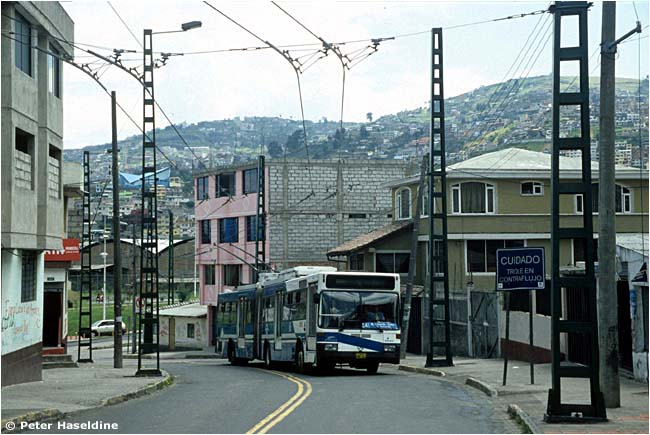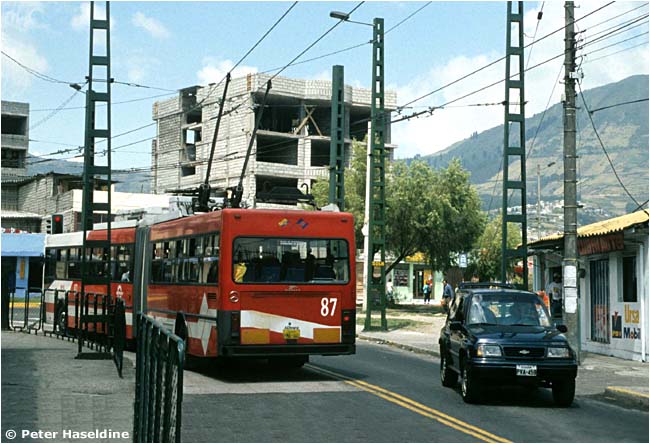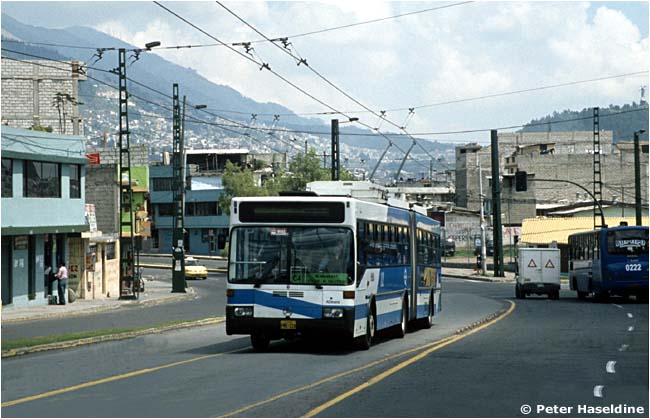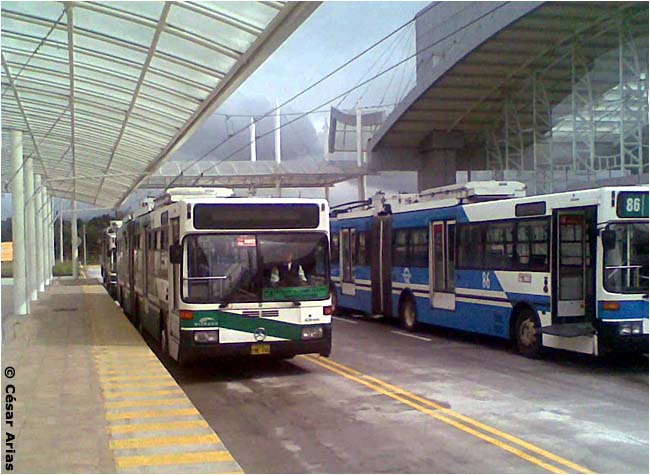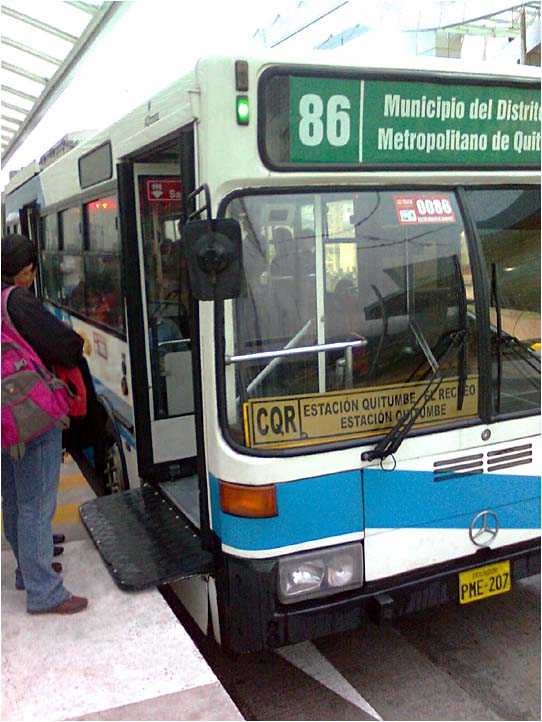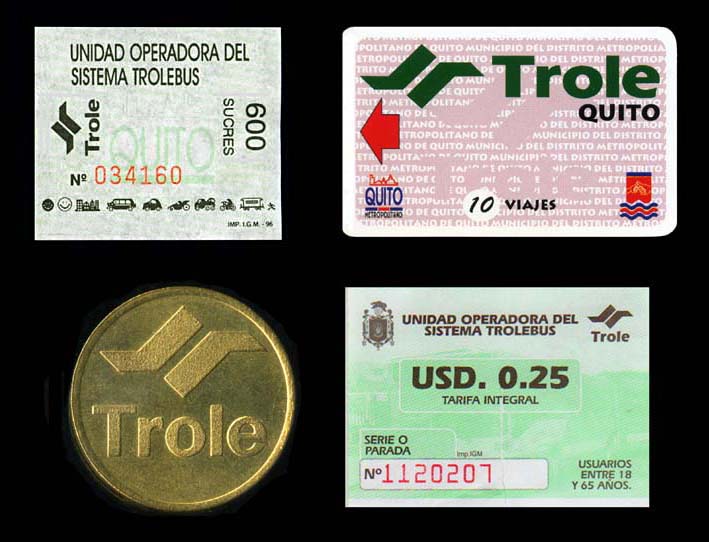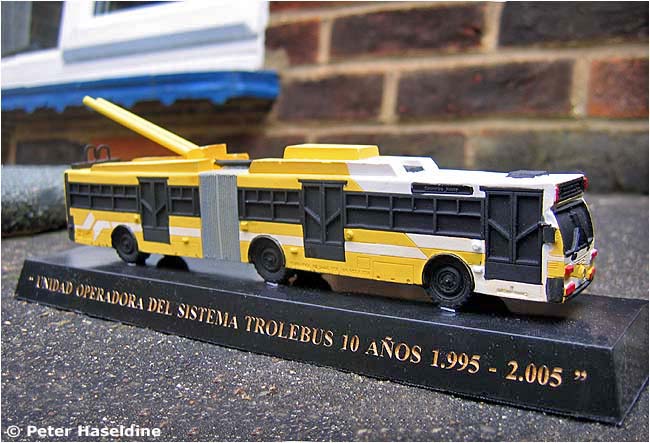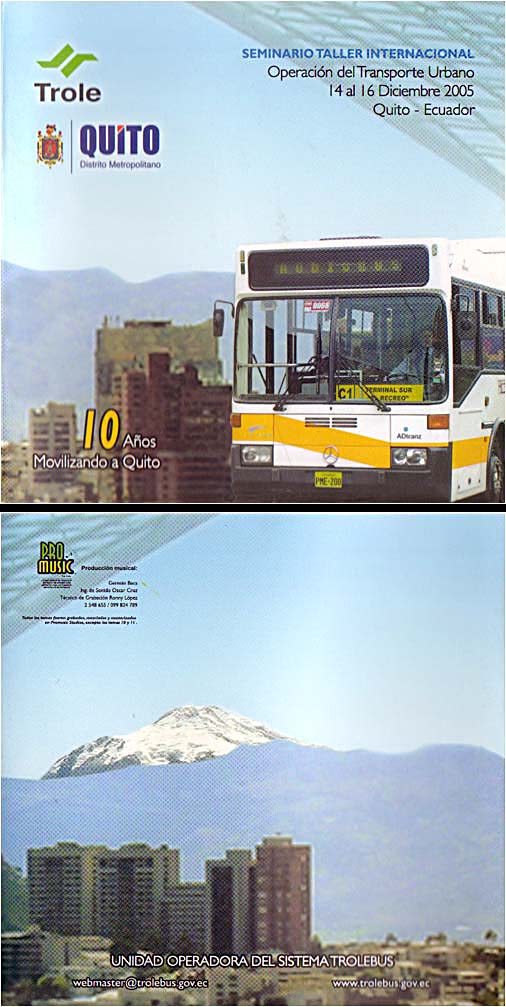El Trole / Los Trolebuses de
The Trolleybus System of
QUITO, ECUADOR
BY
Allen Morrison
Part 3: "Trolesur", Quitumbe [Go to Part 1: Introduction, Av. 10 de Agosto]
"Trolesur", as the extension was nicknamed, runs from Estación El Recreo through a semi-industrial area to the junction of Avenidas Hugo Ortiz and Morán Valverde on the far south side of the city [see map]. It involves two innovations: (1) the placement of larger paradas between the trolleybus lanes – to serve trolleybuses going both north and south – rather than separate paradas on their sides; (2) since they have doors on only the right side, trolleybuses run en contraflujo, against other traffic, on "Trolesur". Where do the trolleybuses change from right-hand drive to left? Two arrangements have been observed since 2002. In October 2007, southbound trolleybuses lowered their poles at the platform in Estación El Recreo, then, using their diesel motors, crossed Av. Maldonado and pulled into the left lane on Calle Moraspungo, as shown in the picture below [see map]. Then they raised their poles into the "pans" and ran electrically again. To change from left to right, northbound trolleybuses lowered their poles here and reattached them in Estación El Recreo. [Peter Haseldine] |
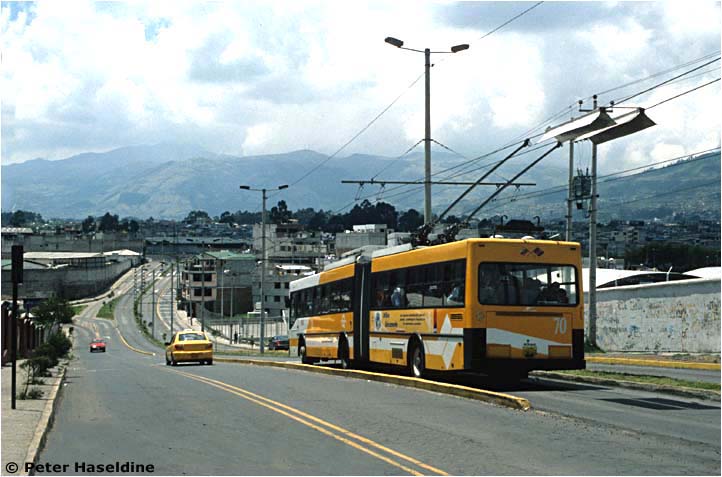
Most of "Trolesur" runs along Av. Hugo Ortiz, a thoroughfare about 1/2 km west of Av. Maldonado [see map]. To reach it, trolleybuses must traverse a narrow street, Calle Antonio Rodríguez [called Av. Circunvalación on some maps]. Since the trolleybuses are running on the left, other vehicles must do the same in this section! The photograph below shows trolleybus 65 on Calle Antonio Rodríguez in October 2007. The sign warns "BEWARE – TROLLEY GOING WRONG WAY". At present, this is the only place in the Americas where trolleybuses run left-hand. [Peter Haseldine]
The little car seems to have been startled, knocked over to the curb by the huge trolleybus on the wrong side of the street. Calle Antonio Rodríguez in October 2007 [see map]. [Peter Haseldine]
Here are the trolleybus lanes in the center of Av. Hugo Ortiz [see map]. Trolleybus 112, traveling southbound against other traffic, is approaching Parada España. Note other vehicles traveling right. Trolleybus 112 has the second-highest number in the Quito fleet. [Peter Haseldine]
Trolleybus 72 going northbound on Av. Hugo Ortiz, approaching Parada Quimiag, in October 2007 [see map]. The vehicle behind is not an invader, but rather a UOST car collecting fare receipts. [Peter Haseldine]
|
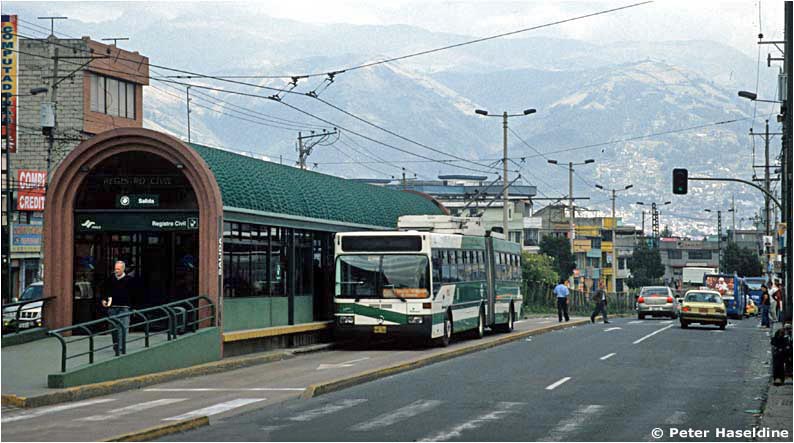
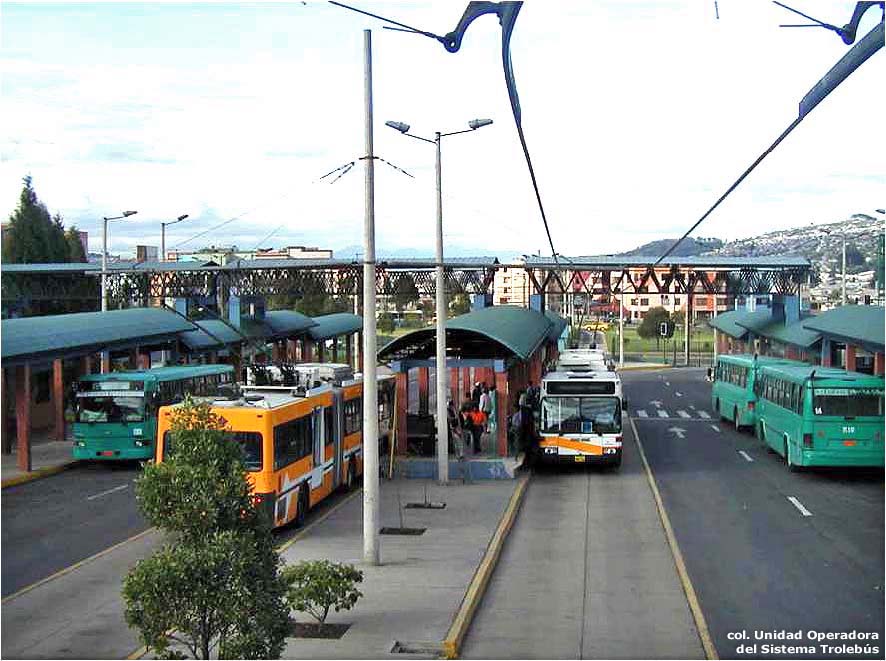
A Google Earth view of Parada Morán Valverde [see map]. Note trolleybuses waiting at the platforms – and three more turning on the clockwise loop below. [Google Earth] |
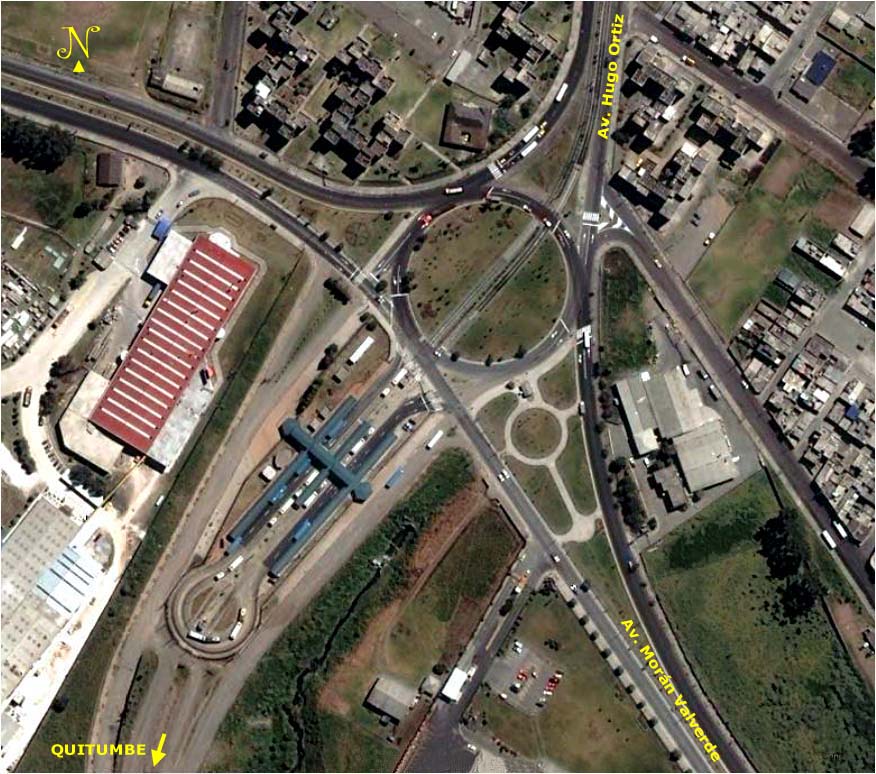
Quito's intercity bus station – near trolleybus Parada Cumandá in the city center – has long been considered inadequate. One of the projects announced in the city's Plan Maestro of 1992 [see Part 1] was the construction of two new terminals to replace it: Estación Carcelén on the city's north side and Estación Quitumbe on the south – each to be served by El Trole and two other reserved-lane bus lines. The trolleybus line to Quitumbe was the first of these segments to be completed. A 2.5 km extension from Morán Valverde to the new USD $25,000,000 Estación Quitumbe was inaugurated on 19 December 2008 [see map]. The photographs below of the Quitumbe area were taken in February 2009. The first shows Av. Cóndor Ñan next to Estación Quitumbe, just out of view on the left [see map]. There is only one trolleybus lane because it is part of a large clockwise loop around the 35-acre complex. Trolleybus 107 has just left the terminal and is headed back to the city – operating left-hand, as is the rule throughout "Trolesur". [César Arias] |
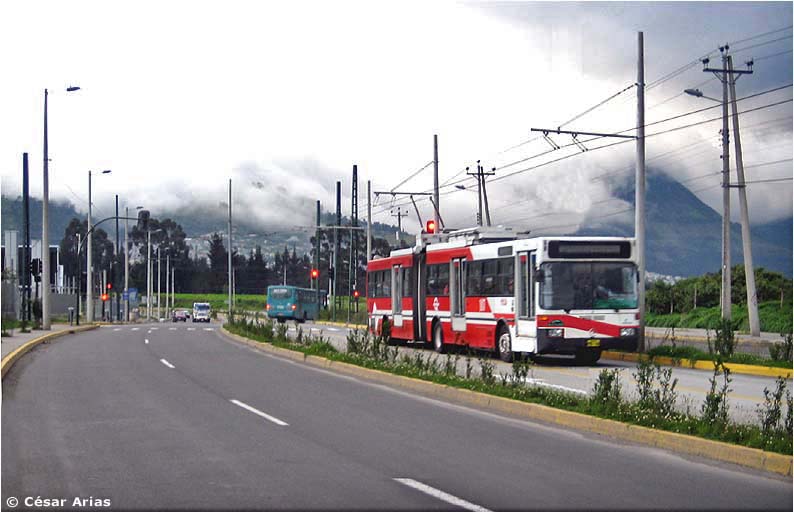
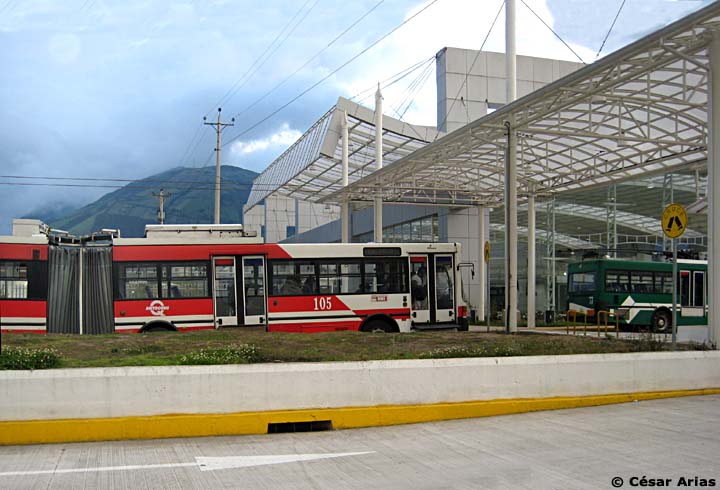
|
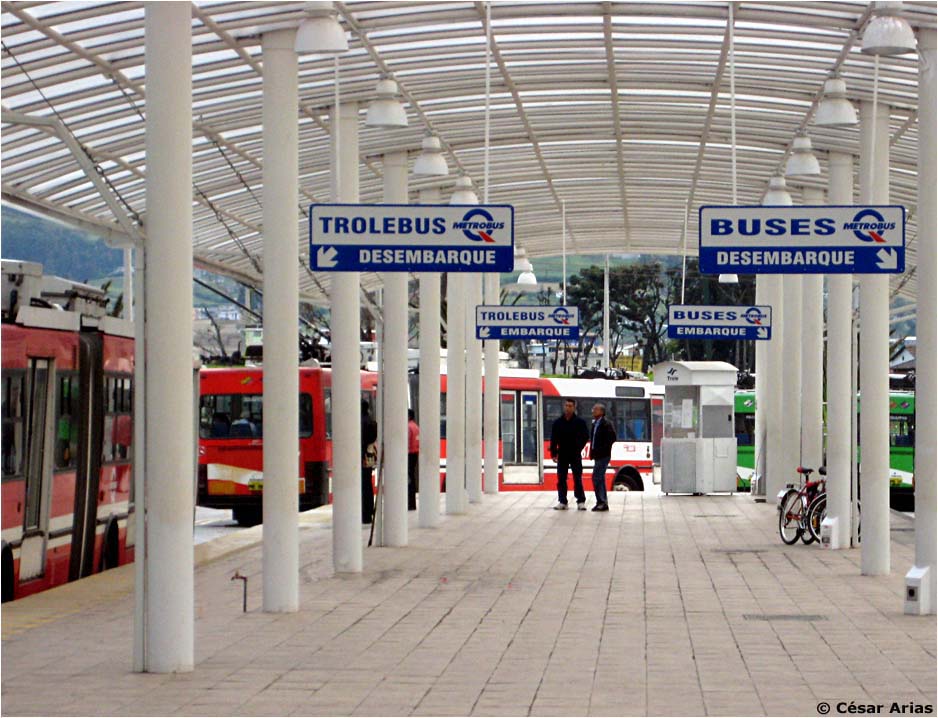
Loading at Estación Quitumbe in February 2009 [see map]. [César Arias]
Quito opened a second express busway called "La Ecovía" along Av. 6 de Diciembre, parallel to Av. 10 de Agosto, in 2001. It has central paradas, like "Trolesur", and its diesel buses run left-hand. Since that time several other "Metrobus" services have started. Operation of the trolleybus system passed to the Compañía Trolebús Quito S.A. in 2007, then to the municipal Empresa Pública Metropolitana de Transporte de Pasajeros de Quito – EPMTPQ – in 2010. The latter is also known as, simply, Empresa de Pasajeros de Quito – EPQ. Plans for a 29 km light rail line named "Tren Rápido de Quito" – or TRAQ – were announced in 2006. But it was finally deemed inadequate and a new organization, Metro de Quito, was formed in 2009 to build a heavy rail line. Metro de Quito hired Metro de Madrid in 2010 to do the job and construction of the 22 km line finally began on 16 January 2013. Its southern and northern terminals will be the same as the trolleybus line's, but because of a more circuitous route the metro will be 3 km longer. The huge, multimodal Terminal El Labrador was built in a corner of the former airport, which closed in February 2013. See trolleybus/metro map. Quito is a fascinating, colorful, friendly place, with unique transport needs. The trolleybuses are fun to ride and, since one of them passes every 90 seconds, fun to photograph. The ticket and token on the left are from March 1996 [col. AM]. The 10-trip pass on the right is from October 1996 – and according to its owner is still good for 7 rides (!) [col. Steve Morgan]. Ecuador adopted U.S. currency in March 2000 and sucres were abandoned completely six months later. The $0.25 ticket was purchased in October 2007 [col. Peter Haseldine].
In 2005 UOST produced trolleybus models to commemorate its 10th anniversary. Units in all six colors were still available at Estación El Recreo in October 2007. This one is numbered 35. (The real 35 is also yellow.) [Peter Haseldine]
El Trole also put out a CD! Most of the music on the disk is conventional, but song number 10 is entitled "Himno del Trolebús" (The Trolleybus Hymn). The digital destination display on trolleybus 68 reads "AUDIOBUS". [Peter Haseldine]
The author is grateful to John Kirchner in Los Angeles, César Arias in Quito, Omar Galarza in New York, Steve Morgan in Portland, and Peter Haseldine in London for the assistance that they provided in the production of this page. Without their photographs, information and encouragement, it would not exist. |
Go to Part 1: Introduction, Av. 10 de Agosto
Go to Part 2: Centro, Av. Maldonado
Continue to Part 4: "El Trolebús", El Labrador
_________________________________________________________________________________________
See my index of
ELECTRIC TRANSPORT IN LATIN AMERICA
If you have comments, criticism or suggestions,
please write to Allen Morrison! Leo y escribo español.
This site was placed online on
14 March 2009
Copyright © 2009-2109 Allen Morrison
ALL RIGHTS RESERVED
TODOS LOS DERECHOS RESERVADOS
